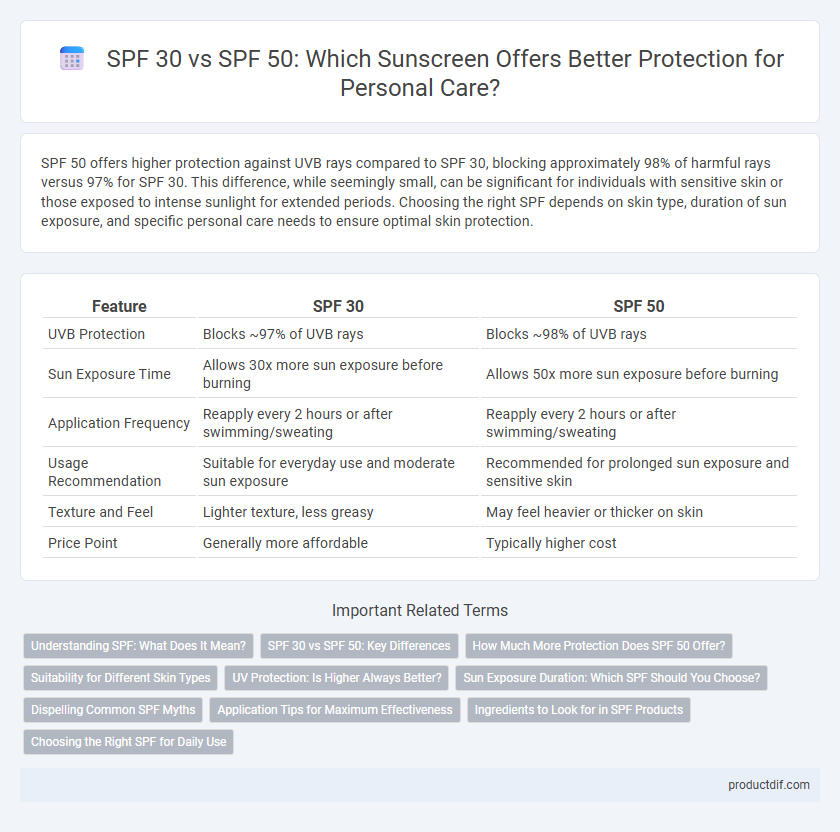SPF 50 offers higher protection against UVB rays compared to SPF 30, blocking approximately 98% of harmful rays versus 97% for SPF 30. This difference, while seemingly small, can be significant for individuals with sensitive skin or those exposed to intense sunlight for extended periods. Choosing the right SPF depends on skin type, duration of sun exposure, and specific personal care needs to ensure optimal skin protection.
Table of Comparison
| Feature | SPF 30 | SPF 50 |
|---|---|---|
| UVB Protection | Blocks ~97% of UVB rays | Blocks ~98% of UVB rays |
| Sun Exposure Time | Allows 30x more sun exposure before burning | Allows 50x more sun exposure before burning |
| Application Frequency | Reapply every 2 hours or after swimming/sweating | Reapply every 2 hours or after swimming/sweating |
| Usage Recommendation | Suitable for everyday use and moderate sun exposure | Recommended for prolonged sun exposure and sensitive skin |
| Texture and Feel | Lighter texture, less greasy | May feel heavier or thicker on skin |
| Price Point | Generally more affordable | Typically higher cost |
Understanding SPF: What Does It Mean?
SPF, or Sun Protection Factor, measures how well a sunscreen protects skin from UVB rays, which cause sunburn. SPF 30 blocks approximately 97% of UVB rays, while SPF 50 blocks about 98%, offering slightly higher protection. Choosing between SPF 30 and SPF 50 depends on skin sensitivity, exposure duration, and environmental conditions.
SPF 30 vs SPF 50: Key Differences
SPF 30 blocks approximately 97% of UVB rays, while SPF 50 blocks about 98%, offering slightly higher protection. The increased SPF number provides longer defense against sunburn, but no sunscreen blocks 100% of UVB rays. Choosing between SPF 30 and SPF 50 depends on skin type, exposure duration, and sensitivity, with SPF 50 recommended for prolonged sun exposure or sensitive skin.
How Much More Protection Does SPF 50 Offer?
SPF 50 blocks approximately 98% of UVB rays, while SPF 30 blocks about 97%, offering only a 1% increase in protection against sunburn. The higher SPF values provide marginally better defense but do not proportionally extend sun exposure time. For effective personal care, reapplying sunscreen every two hours remains crucial regardless of SPF level.
Suitability for Different Skin Types
SPF 30 provides adequate protection for normal to oily skin types without feeling heavy or greasy, making it ideal for daily use. SPF 50 offers higher protection preferred by sensitive or fair skin prone to sunburn and photoaging, ensuring extended defense against UVA and UVB rays. Both SPF levels should be chosen based on skin sensitivity and sun exposure duration for optimal personal care.
UV Protection: Is Higher Always Better?
SPF 30 blocks approximately 97% of UVB rays, while SPF 50 blocks about 98%, indicating marginal differences in UV protection. Higher SPF values provide slightly increased defense but can create a false sense of security, often leading to less frequent reapplication. Effective sun protection depends on broad-spectrum formulas, proper application, and regular renewal rather than solely on SPF number.
Sun Exposure Duration: Which SPF Should You Choose?
SPF 30 blocks approximately 97% of UVB rays, providing adequate protection for most daily sun exposure up to two hours, while SPF 50 blocks about 98%, offering enhanced defense during prolonged outdoor activities exceeding two hours. Choosing between SPF 30 and SPF 50 depends on factors such as skin type, intensity of sun exposure, and duration spent outdoors. For extended sun exposure or sensitive skin prone to burning, SPF 50 is recommended to minimize UV damage and reduce the risk of sunburn.
Dispelling Common SPF Myths
SPF 30 blocks approximately 97% of UVB rays, while SPF 50 blocks about 98%, highlighting that higher SPF offers only marginally better protection. Many users mistakenly believe SPF 50 provides double the protection of SPF 30, but the difference in UVB protection is minimal and often overshadowed by application thickness and reapplication frequency. Proper application and regular reapplication every two hours remain critical factors in effective sun protection, regardless of SPF rating.
Application Tips for Maximum Effectiveness
Apply SPF 30 or SPF 50 sunscreen generously to all exposed skin at least 15 minutes before sun exposure to ensure optimal protection. Reapply every two hours and immediately after swimming, sweating, or towel drying to maintain maximum effectiveness. Using a broad-spectrum formula that protects against both UVA and UVB rays enhances overall skin defense during prolonged outdoor activities.
Ingredients to Look for in SPF Products
SPF 30 and SPF 50 sunscreens often contain active ingredients such as zinc oxide and titanium dioxide for broad-spectrum UVA and UVB protection, with SPF 50 providing a higher concentration for increased defense. Chemical filters like avobenzone, octocrylene, and homosalate enhance absorption and stability, making the product more effective against sun damage. Look for formulations with antioxidants like vitamin E and hyaluronic acid that offer added skin hydration and repair while protecting from harmful UV rays.
Choosing the Right SPF for Daily Use
SPF 30 blocks approximately 97% of UVB rays, making it suitable for everyday sun protection during typical outdoor activities. SPF 50 offers slightly higher protection, blocking about 98% of UVB rays, ideal for extended sun exposure or sensitive skin. Selecting the right SPF depends on individual skin type, daily sun exposure duration, and specific sensitivity to UV radiation.
SPF 30 vs SPF 50 Infographic

 productdif.com
productdif.com